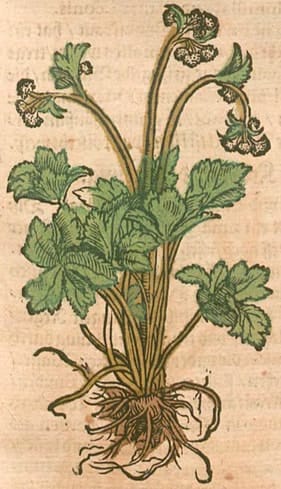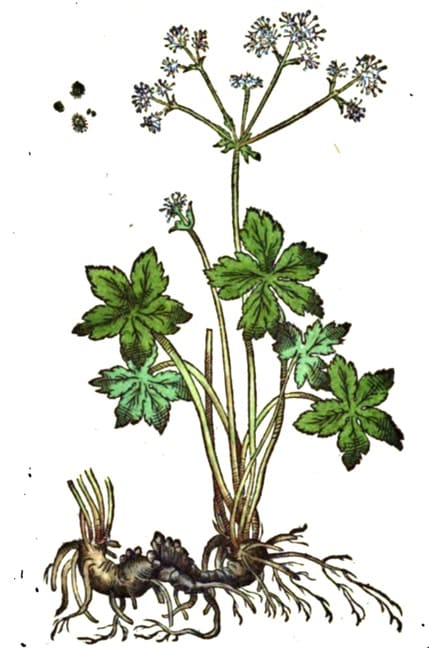Sanicula, Sanicle
Wood Sanicle, Sanicula, Sennicula, Diapensia, Ferraria minor, Consolida minor|
|

|
|
Herbarum Vivae Eicones, Otto Brunfels, 1530 |
Krauterbuch, Lonitzer, 1578 |
 Kreutterbuch, Matthiolus, 1586
Kreutterbuch, Matthiolus, 1586Botanical name:
Sanicula europa
Wirtzung described three separate herbs called and used for Sanicle:
- True (‘Male’) Sanicle
- Alpine Sanicle: fat leaves similar to Plantain, with flowers like Cowslip, blue or purple colored
- ‘Female’ Sanicle: grows in the mountains, leaves similar to Angelica with a black, hairy root
- Common Sanicle
- Spotted Sanicle or ‘London Pride’
- Bear’s Ear Sanicle
- Yorkshire Sanicle or ‘Butterwort’
- Shrubby Sanicle of America
Parts used:
Leaf; rarely the Root
Temperature & Taste:
Warm, dry. Bitter, Salty, astringent
Classifications:
Abstersive, Astringent, Vulnerary, Hysteric
Uses:
1. Astringes and Stops Bleeding:
-Diarrhea, Dysentery, with or without Blood
-Menorrhagia, excessive or heavy menstruation
-Hematuria, bleeding Hemorrhoids, Hemoptysis
-Internal Bleeding, Bleeding Wounds
-Leukorrhea, Spermatorrhea
-leaf is strongest; root has this effect but weaker
2. Moves the Blood, Clears Stasis, Promotes Healing:
-Fresh Wounds, Abscesses
-‘the most excellent of all Wounds herbs’. (Salmon)
-Ulcers, Fistulas, Hernias, Corrosions (int. and ext.)
-Internal Tumors (Salmon)
-Distilled water was used for all types of internal and external Wounds
3. Externally:
-all types of Wounds
-Hernia
-Ulcers and Sores of the Mouth and Throat (decoction sweetened with Honey as a gargle)
-in ointments, or the powder sprinkled on for septic and foul Sores and Ulcers
-draws Thorns and Splinters
Dose:
Powder: 1–3 grams
Decoction in Water or Wine: from one quarter to ½ a Pint
Substitutes:
1. Self Heal
2. Bugle
Main Combinations:
1. Wounds, Trauma:
i. make an infusion with water and wine of Sanicle, Agrimony and Tansy (Wirtzung)
ii. Sanicle with Agrimony, Vervain, Betony, Hyssop, Sage, Mugwort, St. Johns wort; decoct in wine.
iii. Sanicle with Comfrey root, Plantain, Marshmallow, Pimpinella, Licorice (as in Vulnerary Decoction)
iv. Sanicle with Golden Rod, Solomans Seal, Plantain, Sage, Pennyroyal, Century (as in Vulnerary Decoction)
v. Sanicle with Burdock root, Madder, Rhubarb, Bugle and St. Johns wort
vi. A wash for Wounds and Ulcers, Sanicle with Bugle and Self Heal (Culpeper)
2. Hernia:
i. Sanicle with Comfrey root, Solomans Seal, Horsetail (as in Infusion for Hernia)
ii. Sanicle with Rupturewort, Agrimony, Solomans Seal, Plantain, Comfrey root, Burdock, Tormentil, Coriander (as in Decoction for Hernia)
iii. make a plaster with Sanicle, Plantain, Fennel, Golden Rod and Betony and apply (Wirtzung)
3. Gastric Ulcers:
i. Sanicle with Knotgrass, Calendula, Fennel seed (Becker)
ii. Sanicle with Knotgrass, Comfrey, Plantain, Calendula (Becker)
iii. Sanicle with with Centaury, Lanceleaf Plantain, Peppermint, Knotgrass, Potentilla anserina (Görgens)
iv. Sanicle with Angelica, Wormwood, Calendula, Tormentil (Rose)
4. Skin rashes, Sanicle with Walnut leaf, Heartsease, Pimpernel, Sarsaparilla
5. Rupture in a child: ‘Take Sanicle, and bruise it in the hand till it be soft, and lay it to the place ill affected, put a thin clout and truss on it, (Natura exenterata, Philiatros, 1655)
Major Formulas:
Infusion for Hernia (Wirtzung)
Vulnerary Decoction (Wirtzung)
Universal Vulnerary Decoction (Joseph Du Chesne)
Decoction for Hernia
Cautions:
Generally Safe.
Main Preparations used:
Distilled Water of the Herb in Flower
